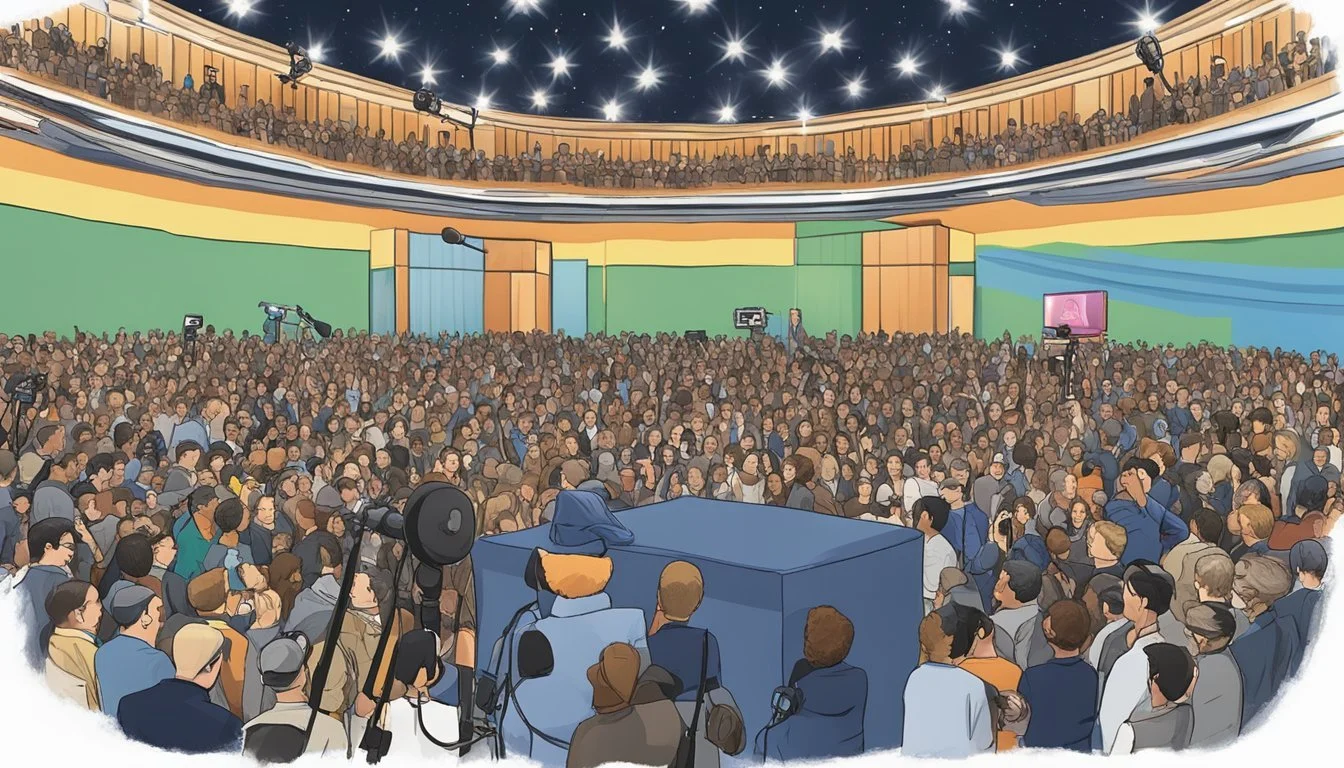Geraldo Rivera: Sensationalism's Poster Child
A Career Built on Controversy
Geraldo Rivera's career in journalism has been marked by sensationalism and controversy. From his early days as a reporter to his long-running talk show, Rivera built his reputation on provocative stories and theatrical presentation.
Rivera's penchant for dramatic exposés propelled him to fame but also drew criticism for prioritizing shock value over journalistic integrity. His 1972 investigation of the Willowbrook State School brought attention to the mistreatment of disabled children, demonstrating the power of his approach to uncover important issues.
Throughout his career, Rivera courted controversy with sensational topics and confrontational interviews. While some praised his willingness to tackle taboo subjects, others accused him of exploiting vulnerable people for ratings. His legacy remains complex, reflecting both the drawbacks and occasional benefits of sensationalism in journalism.
The Rise of Geraldo Rivera
Geraldo Rivera's ascent in television journalism was marked by his embrace of sensational reporting and controversial coverage. His career trajectory blended investigative journalism with provocative storytelling.
Early Career and Sensationalism
Rivera began as a lawyer before transitioning to journalism in the 1970s. He gained national attention with his exposé on the Willowbrook State School, highlighting deplorable conditions for disabled residents. This breakthrough led to a stint on ABC's "Good Morning America" and "20/20."
Rivera's penchant for dramatic storytelling emerged in the 1980s. He hosted "The Mystery of Al Capone's Vaults," a highly-publicized live event that drew massive ratings despite yielding no significant discoveries. This spectacle solidified Rivera's reputation for prioritizing entertainment value in his reporting.
High-Profile Coverage and Controversies
Rivera's career thrived on high-stakes journalism mixed with controversy. He covered major events like the AIDS crisis and the Iraq War, often inserting himself into the stories. His talk show "Geraldo" became known for its volatile content, including a notorious 1988 episode where he suffered a broken nose during an on-air brawl.
Rivera's methods frequently sparked debates about journalistic ethics. Critics accused him of sacrificing integrity for ratings, while supporters praised his ability to bring attention to important issues. His coverage of celebrity scandals and true crime stories further cemented his status as a figurehead of sensationalist media.
Defining Sensationalism
Sensationalism in media refers to presenting information in a way that provokes strong emotional reactions. It emphasizes shocking or scandalous elements to grab attention, often at the expense of accuracy or context.
Sensationalism in Media History
Sensationalism has deep roots in journalism. "Yellow journalism" in the late 19th century used exaggeration and scandal to boost newspaper sales. Tabloids later adopted similar tactics, featuring lurid headlines and stories about crime, sex, and celebrity gossip.
Radio and television amplified sensationalism's reach. Talk shows and "trash TV" in the 1980s and 90s pushed boundaries with outrageous guests and confrontational hosts. News programs increasingly focused on dramatic visuals and emotionally-charged stories.
Sensationalism and Popular Culture
Sensationalism permeates entertainment media. Reality TV thrives on manufactured drama and extreme situations. True crime shows emphasize gory details and psychological madness. Celebrity gossip outlets feed on personal scandals and relationship turmoil.
Social media has further accelerated sensationalism. Clickbait headlines and viral content often prioritize shock value over substance. Online outrage cycles and "cancel culture" can quickly amplify scandals.
Critics argue sensationalism degrades public discourse and exploits human suffering for profit. Defenders claim it draws attention to important issues and reflects genuine audience interests.
The Psychology Behind Sensation
Sensational news taps into fundamental human psychological drives. It activates emotional responses and captures attention through arousal and novelty. This interplay of cognition and emotion shapes how people consume and remember sensational media.
Public's Attraction to Sensational News
Humans are naturally drawn to intense stimuli that elicit strong emotions. Sensational news stories often feature vivid imagery, conflict, and danger - elements that trigger the brain's threat detection systems. This activates the amygdala, releasing stress hormones that heighten alertness and focus.
The novelty of shocking information also stimulates dopamine release, creating a sense of reward. This neurochemical response can lead to a craving for more sensational content. Social psychology research shows people are more likely to pay attention to and share dramatic news stories, amplifying their spread.
The Impact of Sensation on Memory and Perception
Highly arousing sensational information tends to be remembered more vividly and for longer periods. The emotional intensity creates stronger neural connections, enhancing recall. However, this can also lead to distorted perceptions and false memories.
Sensational news can trigger cognitive biases like the availability heuristic, where people judge the likelihood of events based on how easily they come to mind. Exposure to sensational crime stories, for instance, can lead to overestimating crime rates.
Repeated exposure to sensational content may desensitize viewers over time, potentially increasing anxiety or eroding empathy. This psychological numbing can alter how people process information and form opinions about social issues.
Ethics in Journalism
Ethical considerations are paramount in journalistic practice. Reporters must navigate complex decisions about what and how to report while maintaining integrity and public trust.
Balancing Truth and Sensationalism
Journalists face pressure to attract audiences while upholding factual accuracy. Sensationalism can boost viewership but risks distorting truth. Ethical reporters verify claims thoroughly before publishing. They present information objectively without exaggeration.
Some outlets prioritize clicks over substance. This erodes credibility over time. Responsible journalists resist the urge to sensationalize for short-term gains.
Fact-checking and editorial oversight help maintain standards. Multiple sources should corroborate key claims. Context is crucial for audience understanding.
Journalistic Responsibility and Public Trust
Reporters serve as public watchdogs and information providers. This role carries weighty ethical obligations. Journalists must strive for fairness, accuracy, and transparency.
Building trust requires consistent ethical conduct. Corrections should be issued promptly when errors occur. Conflicts of interest must be disclosed or avoided.
Protecting sources is often an ethical imperative. However, journalists should verify source credibility. They must also consider potential harm from publishing sensitive information.
Public trust in media institutions has declined in recent years. Rebuilding it demands unwavering commitment to ethical practices across the industry.
The Cultural Impact of Geraldo Rivera
Geraldo Rivera's influence on media and popular culture is undeniable. His bold reporting style and controversial programming shaped crime coverage and sensationalist content on television for decades.
Influence on Crime Reporting
Rivera's 1972 exposé on the Willowbrook State School revolutionized investigative journalism. His aggressive approach brought attention to societal issues often ignored by mainstream media. This style influenced a generation of reporters to pursue hard-hitting stories with dramatic flair.
Rivera's coverage of high-profile criminal cases captivated audiences. His reporting on the Son of Sam killings and the opening of Al Capone's vault became cultural touchstones. These events blurred the lines between news and entertainment, setting a precedent for future crime coverage.
Contributions to Television and Sensationalist Content
Rivera's talk show "The Geraldo Rivera Show" ran for over a decade, popularizing confrontational television. The program featured heated debates, shocking revelations, and occasional physical altercations. This format paved the way for future tabloid talk shows and reality TV confrontations.
His willingness to tackle controversial topics pushed boundaries in television content. Rivera's coverage of Satanism and his infamous chair-throwing incident became defining moments in 1980s pop culture. These events sparked debates about journalistic ethics and the role of sensationalism in news media.
Rivera's later transition to Fox News further solidified his status as a polarizing figure in American media. His ongoing presence on television continues to shape public discourse on crime, politics, and social issues.
Access and Consumption of Sensational Media
Media institutions and individual preferences shape how people encounter and engage with sensational content. Access methods range from broad institutional subscriptions to personalized accounts on digital platforms.
The Role of Institutional Access
Many organizations provide widespread access to media through institutional subscriptions. Universities often offer students and faculty IP-based access to news databases and journals. Public libraries similarly grant patrons entry to a range of publications.
Corporate subscriptions allow employees to view content across devices. Some government agencies maintain media monitoring services, aggregating sensational stories from various outlets. These institutional access points expose large groups to potentially sensationalized material.
Individuals and Personalized Media Consumption
Personal media accounts give individuals more control over their content diet. Social media platforms use algorithms to show users posts that align with their interests and past engagement. This can create echo chambers that amplify sensational stories.
News apps and websites track reading habits to suggest similar articles. Push notifications alert users to breaking stories, which often employ dramatic language. Subscription-based services like Netflix recommend sensational documentaries based on viewing history.
Ad-supported platforms rely on clickbait headlines to drive traffic. Users' browsing data informs targeted ads, which may promote sensational content. IP-based geolocation tailors news feeds to local sensational events.
Commercialization and the Media
The media landscape has been profoundly shaped by commercial forces and the pursuit of profit. This has led to a prioritization of sensationalism and spectacle to capture audience attention and drive revenue.
Capitalism's Influence on Media Sensations
Capitalism's profit motive has pushed media outlets to prioritize sensational content that attracts viewers and advertisers. Outlets compete for audience share by highlighting shocking stories and dramatic narratives. This trend accelerated with the rise of 24-hour cable news in the 1980s.
Sensationalism sells papers and drives ratings. Media companies discovered they could boost profits by focusing on scandal, crime, and controversy. This led to an emphasis on emotionally charged reporting over nuanced analysis.
The pressure to deliver constant content and meet revenue targets often results in a rush to publish before facts are fully verified. Speed trumps accuracy in the race for clicks and views.
Media as a Spectacle and Entertainment
News and current affairs programming has increasingly adopted the techniques of entertainment media. Complex issues are simplified into easily digestible narratives with clear heroes and villains.
Visually striking graphics, dramatic music, and heightened emotions are used to create a sense of urgency and keep viewers engaged. Political debates are framed as sporting events, with post-game analysis and scorekeeping.
Personality-driven shows blend news, opinion, and entertainment. Hosts like Geraldo Rivera built their brands on provocative stunts and confrontational interviews designed to shock and titillate audiences.
Print media has not been immune. Tabloid journalism and sensationalized headlines aim to boost newsstand sales through exaggeration and spectacle.
Analyzing and Critiquing Media Narratives
Media narratives shape public perception through storytelling techniques and emotional appeals. Effective analysis requires examining how emotions are leveraged and comparing approaches across different media outlets.
The Role of Emotion and Affect in Storytelling
Emotional storytelling is a powerful tool in media narratives. News outlets often use emotive language and vivid imagery to engage audiences. This approach can make stories more memorable and impactful.
Affect plays a crucial role in how viewers process information. Strong emotional responses can override critical thinking. Media critics argue this can lead to biased or incomplete understanding of complex issues.
Geraldo Rivera's reporting style exemplifies the use of emotion in storytelling. His dramatic presentations and confrontational approach aim to provoke strong reactions from viewers.
Comparisons in Media Sensationalism
Different media outlets employ varying degrees of sensationalism. Tabloid journalism typically embraces more dramatic storytelling than traditional news sources. Some argue this approach sacrifices accuracy for entertainment value.
Cable news networks often fall between these extremes. They may use sensational elements to attract viewers while maintaining some journalistic standards. Critics argue this blurs the line between news and entertainment.
Online media introduces new dimensions to sensationalism. Clickbait headlines and viral content push the boundaries of traditional journalism. This shift challenges readers to critically evaluate sources and content reliability.
Geraldo Rivera's Legacy and Influence
Geraldo Rivera's career left an indelible mark on American media. His sensationalistic approach shaped television journalism and public discourse for decades.
Assessing the Long-Term Impact
Rivera's legacy is complex and multifaceted. His investigative work, like exposing the Willowbrook State School's abuses, brought important issues to light. This reporting led to significant reforms in mental health care.
Rivera's talk show popularized confrontational interview styles. This approach influenced future programs and changed audience expectations. His willingness to tackle controversial topics expanded the boundaries of acceptable TV content.
Critics argue Rivera prioritized shock value over journalistic integrity. This tendency contributed to a blurring of lines between news and entertainment.
Reflections on Sensationalism and Media's Future
Rivera's career highlights ongoing debates about media ethics. His approach raises questions about the balance between engaging audiences and maintaining journalistic standards.
The rise of social media and citizen journalism echoes some of Rivera's tactics. Both prioritize immediacy and emotional impact over in-depth analysis.
Media literacy has become increasingly important in the digital age. Rivera's sensationalistic style underscores the need for critical consumption of news and information.
The future of journalism may involve finding new ways to captivate audiences without compromising accuracy. Rivera's career serves as both a cautionary tale and a source of lessons for aspiring journalists.







